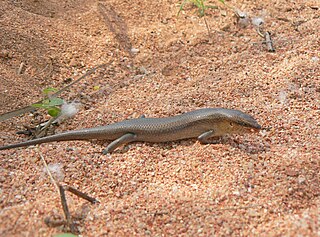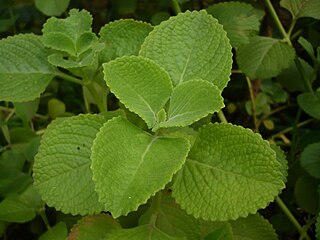Cephalocroton is a genus of plant of the family Euphorbiaceae first described as a genus in 1841. It is native to central, eastern, and southern Africa from Nigeria and Ethiopia south to KwaZulu-Natal.
Cephalocrotonopsis is a genus of plant of the family Euphorbiaceae first described as a genus in 1910. It contains only one known species, Cephalocrotonopsis socotranus, endemic to the Socotra Islands in the Indian Ocean, part of the Republic of Yemen.
Hibiscus socotranus is a species of flowering plant in the family Malvaceae. It is found only in Yemen. Its natural habitat is subtropical or tropical dry shrubland.

Hakaria is a genus of skink, a lizard in the family Scincidae. The genus contains one species, Hakaria simonyi, which is endemic to Socotra.
Andropogon bentii is a species of grass in the family Poaceae. It is found only in the Socotra archipelago in the Indian Ocean, a part of Yemen. Its natural habitat is succulent and dwarf shrubland on limestone escarpments and plateaus.
Coleus socotranus, synonym Plectranthus socotranus, is a species of flowering plant in the family Lamiaceae.
Coleus unguentarius, synonym Plectranthus socotranus, is a species of flowering plant in the family Lamiaceae. It is found only in Namibia. Its natural habitat is rocky areas. It is threatened by habitat loss.

Acridocarpus is a genus of plant in family Malpighiaceae. They are native to Arabia and tropical and subtropical Africa, with one species in New Caledonia.

Helicia is a genus of 110 species of trees and shrubs, constituting part of the plant family Proteaceae. They grow naturally in rainforests throughout tropical South and Southeast Asia, including India, Sri Lanka, Indochina, Peninsular Malaysia to New Guinea and as far south as New South Wales.
Ochradenus socotranus is a species of plant in the Resedaceae family. It is endemic to Yemen. Its natural habitat is rocky areas.
Convolvulus socotranus is a species of plant in the family Convolvulaceae. It is endemic to Socotra. Its natural habitat is subtropical or tropical dry shrubland.

The Socotra Island xeric shrublands is a terrestrial ecoregion that covers the large island of Socotra and several smaller islands that constitute the Socotra Archipelago. The archipelago is the western Indian Ocean, east of the Horn of Africa and south of the Arabian Peninsula. Politically the archipelago is part of Yemen, and lies south of the Yemeni mainland.

The Somali golden-winged grosbeak or Somali grosbeak is a finch endemic to Somaliland. It is included as a subspecies in R. socotranus by some authorities, but in recent times the three golden-winged grosbeak populations are usually considered distinct species.

The Arabian golden-winged grosbeak or Arabian grosbeak is a finch found in Saudi Arabia, Oman and Yemen. It is included as a subspecies in R. socotranus by some authorities, but in recent times the three golden-winged grosbeak populations are usually considered distinct species.

The Socotra golden-winged grosbeak or Socotra grosbeak is a finch endemic to Socotra, an island in the Indian Ocean off the coast of Yemen. R. socotranus is by some authorities held to be the only species of the then-monotypic genus Rhynchostruthus, including all other golden-winged grosbeaks therein as subspecies. But in recent times the three populations are usually considered a distinct species, with R. socotranus being limited to the Socotra population, the Arabian golden-winged grosbeak becoming R. percivali, and the Somali golden-winged grosbeak R. louisae.

Dendrosicyos is a monotypic genus in the plant family Cucurbitaceae. The only species is Dendrosicyos socotranus, the cucumber tree. The species is endemic to the island of Socotra in Yemen, and is the only species in the Cucurbitaceae to grow in a tree form. The species name was originally spelled D. socotrana, but this is corrected to masculine grammatical gender according to the International Code of Nomenclature for algae, fungi, and plants.

The Socotra scops owl is a small owl endemic to the island of Socotra, Yemen.

Cissus subaphylla is a low shrub in the grape family Vitaceae. It is endemic to the Yemeni island of Socotra. The plant grows mainly in dry, low-lying areas on alluvial fans or on limestone slopes, and is rarely found above elevations of 300 metres (980 ft), where it is replaced by C. hamaderohensis. It does not have the climbing habit of other Cissus species, and its stems are flattened and gray-green in colour, with relatively small leaves and flowers. The tangled mats of C. subaphylla stems act as a protective covering for plants regularly eaten by goats and other browsing animals; the plant is thus important in the rehabilitation of species such as Dendrosicyos, Maerua and Commiphora.
Acridocarpus monodii is a species of plant in the Malpighiaceae family. It is endemic to central Mali, where it is limited to the Bandiagara Escarpment region, in the ecotone of the West Sudanian Savanna and Sahelian Acacia Savanna.

Coleus is a genus of annual or perennial herbs or shrubs, sometimes succulent, sometimes with a fleshy or tuberous rootstock, found in the Old World tropics and subtropics. The relationship among the genera Coleus, Solenostemon and Plectranthus has been confused. Coleus and Solenostemon were sunk into Plectranthus, but recent phylogenetic analysis found Plectranthus to be paraphyletic with respect to other related genera in the subtribe Plectranthinae. The most recent taxonomic treatment of the genus resurrected Coleus, and 212 names were changed from combinations in Plectranthus, Pycnostachys and Anisochilus. Equilabium was segregated from Plectranthus, after phylogenetic studies supported its recognition as a phylogenetically distinct genus.











